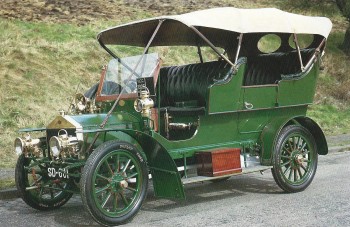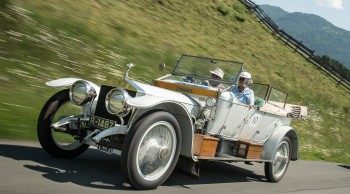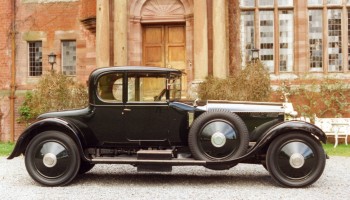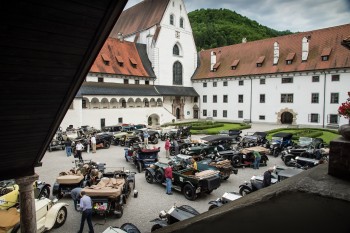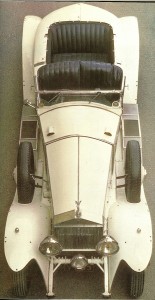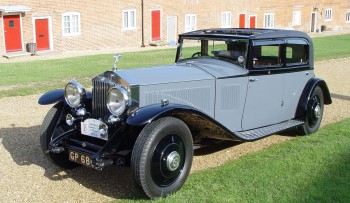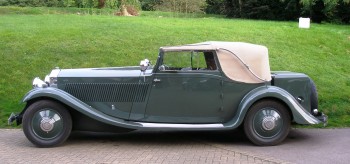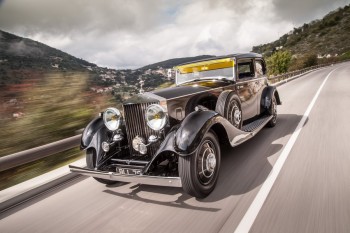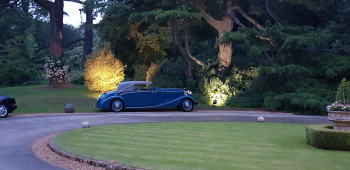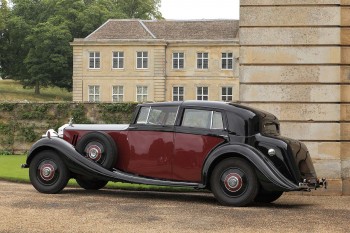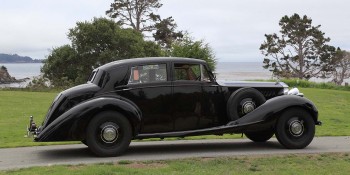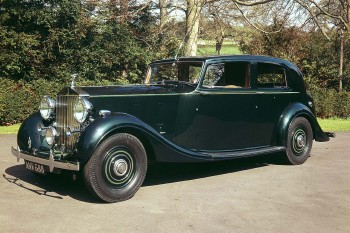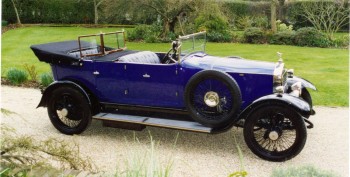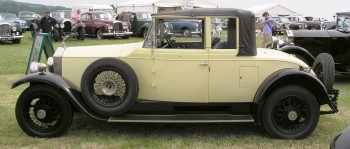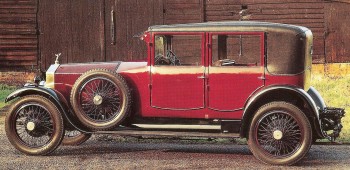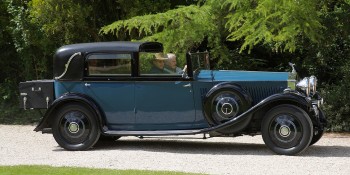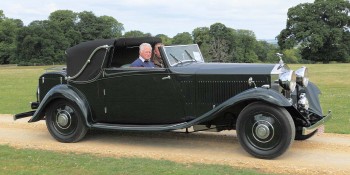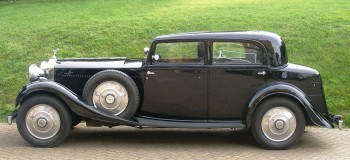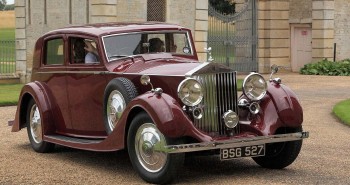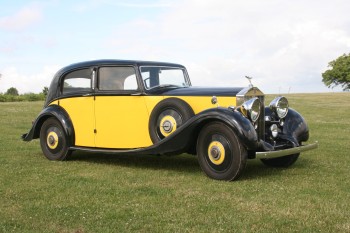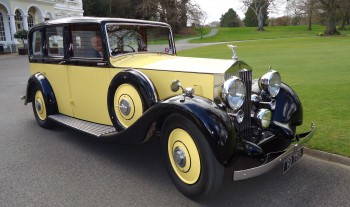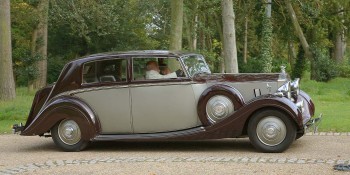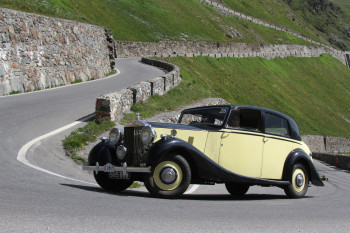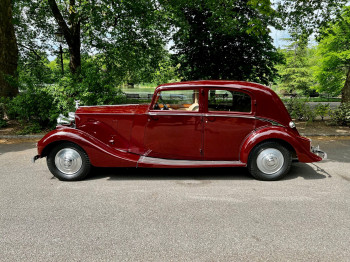EARLY ROLLS-ROYCE CARS 10 HP, 15 HP, 20 HP AND 30 HP
The first Rolls-Royce was a twin cylinder car of 10HP made from 1904 to 1906. This was shortly followed by a three-cylinder 15HP and a four-cylinder 20HP which came in both a heavy chassis form for carrying Limousine coachwork and light chassis form for a more sporting Tourer. A Light 20 came 2nd in the International Tourist Trophy race in the Isle of Man in 1905 and won it in 1906. This enabled Rolls-Royce cars to gain an early reputation for quality and endurance. Also available was the V8 Legalimit and the six-cylinder 30HP. Of these early cars the best was the four-cylinder 20HP of which 40 were built and those that survive are light and quite fast cars, which are a pleasure to drive. However, few of any of these very early models have survived and they are in a very rarefied market.
Compared to most veteran cars of the same period, they are noticeably quieter and smoother with a lightness and precision of control that makes them much pleasanter to drive. They are however best used for the shorter events typically run by the Veteran Car Club or within The 20-Ghost Club for the more leisurely events such as driving tests and Concours d’ Etat.
FURTHER INFORMATION
For further information or queries regarding this model, please use the Contact Us form to send a message to the designated early Rolls-Royce 10 HP, 15 HP and 20 HP specialist in the Club.
ROLLS-ROYCE SILVER GHOST
From 1907 to 1923 Rolls-Royce had a one model policy, making what was known initially as the 40/50 and later as the Silver Ghost. The car was an immediate advance on its contemporaries with pressurised engine lubrication, dual ignition and advanced carburation giving the car both a very flexible and smooth power delivery, and great reliability and longevity. The car’s reputation was immediately established in England in a series of reliability trials, the most famous being the 1907 RAC 15,000 mile reliability trial.
The car was introduced in late 1906 with a 7 litre engine, shortly increased to 7½ litres, and remained in production in the UK until 1925 and in the USA until 1926. As a result of competition in the Austrian Alpine Trials of 1912, significant improvements were made in 1913 and 1914 to increase the cooling capacity, replace the three-speed gearbox with one of four speeds and to increase the size of the brakes. The resulting car was so good that it justifiably earned the name of ‘The Best Car in the World’ and it stayed in production through the 1920s, beating strong market competition because of its elegance, smoothness, refinement and quietness of operation.
A staggering 6,173 units of this model were produced and exported all over the world, with a further 1,703 being produced at a Rolls-Royce factory established in the USA at Springfield, Massachusetts. The engine is a large very quiet side valve with coil and magneto ignition. From 1919 onwards electric starters were fitted and, from 1924, very powerful servo-assisted front wheel brakes became available.
In 1911 a sporting version of the car was introduced and this model was given the name ‘London to Edinburgh’ after it had been driven in top gear between the two cities in an RAC observed run. This car was lighter and lower than standard, with a tapered bonnet and was capable of a maximum speed of 80 mph at a time when most cars were stretched to reach 40 mph and the National speed limit was 20mph! This car is still one of the most delightful of all Rolls-Royces to drive, with a lightness and precision of control that is unmatched by any other model.
Between 1911 and 1913 there were 188 London to Edinburgh cars produced. Then, after the disastrous performance by James Radley in the 1912 Alpine Trials, Rolls-Royce introduced a four-speed gearbox. Commencing with the 2400 series in 1913 almost all the Colonial or Continental London to Edinburgh cars were fitted with four-speed gearboxes. After the Company’s success in the 1913 Alpine Trials, from late 1913 (from chassis number 2699 onwards), these cars were referred to as Alpine Eagles or AE in the factory records. The Alpine Eagle was generally fitted with lightweight open coachwork, light road springs and lower steering rakes.
This sporting version, from late 1913, became known as Speed or even Alpine Eagle High Speed models in the early 1920s, fitted with lighter aluminium pistons. Gradually virtually all the improvements were incorporated into the standard chassis. Throughout its life the car was available with a variety of body styles from the very best coachbuilders, ranging from grand touring cars to magnificent limousines. As well as its other virtues, the chassis was very well proportioned and enabled extremely elegant coachwork to be fitted.
Compared to later models, a high proportion of the early cars carried open touring coachwork, as the cars were mainly used in the country during good weather for pleasurable entertainment. Only after WWI did cars become used for longer journeys and in all weathers. As a result, as time passed, coachwork became heavier and more enclosed, so providing increased comfort and protection for the passengers.
Owning a Silver Ghost
Of all the pre-1939 Rolls-Royces, the Silver Ghost is the most demanding to maintain and drive, but is also probably the most rewarding as not only are the details of its construction fascinating, but it is also a very enjoyable car to drive, particularly when fitted with relatively light open coachwork.
Another great advantage of owning a Silver Ghost, these days, is that they are eligible for certain special events that are only open to Silver Ghosts made either in the UK or the USA. These events are run principally in Europe, the United States and Australia.
Maintenance
Preparing and maintaining a Silver Ghost before an event will typically take at least half a day as there are so many individual lubricators to attend to. Sir Henry Royce started out as a locomotive engineer and it shows in that everything requires lubrication, some of it daily and most of it on a weekly basis. After a winter lay up a full lubrication service is required. Therefore getting the car ready for an outing in the spring takes time to ensure the car is properly prepared.
Later post-war Ghosts are slightly quicker to lubricate as they use a gun and Enots connectors to oil each point rather than a cap which has to be unscrewed, filled with oil, replaced and then tightened again. Once on a tour there are lubrication schedules to be done every 250 miles and every 1000 miles, so that car parks on tour become quite social, as well as oily, places as the various routines are accomplished!
Tyres on pre-war cars were of the beaded edge type, which give very little contact with the road and are liable to failure if used on longer tours. Therefore, many touring cars have been converted to the much more reliable straight sided tyres which give better service and are readily available.
Driving and performance
Driving a Silver Ghost is all about confidence and the ability to adapt one’s style to that of the car. Chauffeurs were invited to change into top gear as quickly as possible and stay there, allowing the massive torque of the engine to pull away from quite low speeds.
The gearbox is there for starting from rest and for climbing really steep hills. If the car was made between 1910 and 1913 it is likely to have three speeds otherwise it will have four. The gear lever is on the right, adjacent to the handbrake. The change of gears is relatively straight forward once you have remembered or learnt how to double de-clutch and accept the fact that some gear changes will inevitably involve a certain gnashing of teeth, by the driver and the car!
The pedal layout is conventional and there is a hand throttle, mixture control and ignition control on the top of the steering column. Once under way these rarely need adjusting unless one wishes to use the hand throttle as a ‘cruise control’.
Acceleration away from traffic lights is good enough to surprise other motorists but, in reality, it is fairly leisurely by modern standards. Cruising speed depends on the gearing but Ghosts will cruise all day at 50 mph or more. Many of the touring cars and all of the more sporting Silver Ghosts were very highly geared and these can comfortably cruise at 55 to 60 mph without difficulty.
Post-war Silver Ghosts have a slightly different feel to them as they are heavier and typically somewhat lower geared but compensate for this by being better braked. The engines were designed to run slightly faster with aluminium pistons and so, although their performance is similar to a pre-war Ghost, it does not come with quite the effortless sense of ease of the early cars.
However this all depends on road conditions and one needs to remember that, on most Silver Ghosts, the brakes act only on the rear wheels. On pre-1914 cars the foot brake operates a drum on the transmission which, although powerful, was subject to dire warnings by the factory as excessively rapid stops could damage the transmission. In fact the handbook told the driver to slow the car by closing the throttle! Fortunately, the large handbrake lever operates very effective drum brakes on the rear wheels that work well in dry weather. When the roads are wet caution is advised as, with two wheel brakes and narrow tyres a, sometimes uncontrollable, skid can be caused by heavy braking.
From 1914 onwards, Ghosts had both handbrake and footbrake operated brakes on the rear axle; from 1924 the front wheel brakes were fitted with a powerful servo. Both of these enhanced the braking capabilities significantly.
Steering, apart from when the car is parked, is very precise and light with very little movement at the wheel needed to take a corner. Once underway the car is therefore both relaxing and easy to drive with top gear giving relaxed acceleration from 10 mph to 70 mph, light direct steering and very quiet engine and transmission. The biggest noise is from the wind which varies with the type of coachwork fitted.
FURTHER INFORMATION
For further information or queries regarding this model, please use the Contact Us form to send a message to the designated Rolls-Royce Silver Ghost specialist in the Club.
ROLLS-ROYCE PHANTOM I
A Phantom I is very similar to a later type Silver Ghost as the main change was to the engine, leaving the chassis, suspension, gearbox and braking just as they were on the later Ghosts. The engine was an overhead valve rather than side valve and the stoke of the engine was considerably increased from 120 mm to 140 mm whilst the bore was reduced from 114 to 108, to reduce road taxation. This engine produced 25% more power but unfortunately the chassis weight of the car, with the new engine, four-wheel brakes and the larger well base wheels and tyres, increased from around 3,400 lbs for a typical Silver Ghost to 4000 lbs for the Phantom I. The radiator height was increased and this coupled with the large headlights and often capacious bodywork meant that both the overall weight and wind resistance increased compared to the Silver Ghost.
The Phantom I, or New Phantom as it was originally known, proved popular although it had quite a short production run from 1925 to 1929. Despite this, 2,267 were built in the UK and a further 1,244 in the USA where production continued into 1931.
Coachwork evolved in the 1920s from the rather upright style suitable for the wearing of top hats to something lower and more elegant by the end of the Twenties. The Phantom I benefited from this trend and often received very elegant coachwork from the best British coachbuilders, as by 1925 there was little strength of competition in England from domestic or foreign manufacturers.
Owning a Phantom I
The pleasure of owning a Phantom I is often gained from the style in which one is travelling rather than being exposed to the elements, as one often is in a Silver Ghost. The style is very much of the twenties sometimes with wonderful art deco interiors. These cars with their size and easy touring capabilities are ideal for the ‘Grand Tour’, as long as one can stand the hefty fuel bills!
Maintenance
Maintenance is very similar to a late model Silver Ghost with four wheel brakes. There are no less than 84 points to oil every 1,000 miles but at least this is done with an oil gun. Since the valve gear is totally enclosed it does not need periodic lubrication unlike the Silver Ghost. The US built New Phantoms were the first to have one-shot chassis lubrication, with a lever beside the driver, injecting oil to no less than 40 points around the chassis.
Driving and performance
The Phantom I was typically rather lower geared than a Silver Ghost so that the engine could, for most of the time, be held in top gear despite the weight of the car and its coachwork. Driving a Phantom I is like driving a powerful late Silver Ghost, but you are conscious that the engine is turning a little bit faster, with a different rhythm to it.
Performance depends very much on the type of coachwork and therefore gearing fitted. Larger limousines cruise at 55 mph whereas the lighter Tourers or Saloons on a standard chassis can cruise at 60 to 65 mph all day without difficulty. Top speed is dependent on gearing and body style and varies from 65 mph for a long wheelbase limousine to over 80 mph for a light Tourer.
The steering on these cars tends to be heavier than on a Silver Ghost, particularly at low speeds, due to the much larger section balloon tyres fitted. Ride and comfort on these tyres is much improved as is the braking capability. The engines if well restored and maintained can be extremely quiet and smooth.
FURTHER INFORMATION
For further information or queries regarding this model, please use the Contact Us form to send a message to the designated Rolls-Royce Phantom I specialist in the Club.
ROLLS-ROYCE PHANTOM II
The success of the Phantom I had given Henry Royce time to redesign completely the large horse-power car; so when the Phantom II was announced in 1929 the car made a tremendous impact. The whole appearance of the car was changed by redesigning entirely the chassis and springing; thus, when carrying closed coach work, the overall height of the car was reduced by 9 inches (230 mm). This gave the car a wonderfully modern low slung look, making the Phantom I seem as though it was from a different era.
The car also had a new engine of almost identical capacity as the Phantom I but which gave a significant 30% power increase in its final form. For the first time, the gearbox was attached directly to the engine rather than being a separate unit. Another big improvement was the use of a centralised single-shot lubrication system replacing the need to use an oil gun to lubricate each part individually. Another significant improvement for a modern day driver is that synchromesh was fitted to third and top gears, but not to first or second.
The Phantom II entered production in 1929 and the last unit was produced in 1935. Because of the Wall Street crash of 1929 and the following years of The Depression, only 1,693 were built. However of these, 281 were Continentals, built especially for the enthusiastic owner driver who particularly liked speed and performance. The axle ratio was raised to give a higher cruising speed and special dampers were fitted to provide improved control at high speed. As Rolls-Royce put it, the car was designed to ‘meet demand for a model capable of maintaining high speeds on Continental roads’. Over 1,100 examples of the Phantom II are known to have survived.
The Phantom II Continental was the last car to be designed under the personal supervision of Sir Henry Royce, before his death in 1933. Built as a fast continental touring car, only 281 examples of this model were produced. A pre-production model won the Grand Prix d'Honneur in the Concours d'Elegance at Biarritz in 1930.
The Phantom II and the Continental Phantom II both attracted some of the most elegant coachwork of the period, enabling Rolls-Royce to win several of the prestigious Concours d’ Elegance that were held at that time. Today their lines cannot do anything but impress and some of the two-door cars are the most elegant and stylish of all the pre-1939 Rolls-Royces.
Owning a Phantom II
Anyone owning one of these cars will know that it will be admired wherever it appears because of the elegance of its lines and its sheer presence. The car is easier to maintain than the earlier cars, has more performance and better handling. It is particularly suited to long distance touring; but is equally at home pottering around the English countryside or attending a Concours d’ Elegance where it will most likely win!
Maintenance
By the time the Phantom II was introduced, many owners, particularly of the Continental, expected to drive their cars extensively without support from a chauffeur. Keeping the car clean had been helped by improvements in the type of paint used and by the adoption of wheel discs which greatly reduced the time needed to wash the car. The previously Nickel plated Radiator shell gave way to Staybright in 1931 (a form of stainless steel) and, from its inception, the Phantom II had a one-shot lubrication system.
All of these features mean that the car is rather easier to keep clean and particularly to lubricate than one of the earlier large horsepower cars. It is still however a very large car.
These very large six cylinder Rolls-Royces are big powerful cars and, in general, the engines are very reliable as they are quite lowly stressed. However, with the Phantom II, particularly as it was developed to deliver even more power, the engine began to show signs that it was a very big six cylinder engine that was having to work quite hard to meet the performance expectations of owners. These engines did therefore show signs of wear rather quicker than had their predecessors. Both late Phantom Is and all Phantom IIs have aluminium cylinder heads, which were very satisfactory provided the correct inhibitors were used to prevent corrosion. These engines therefore need to be carefully checked and maintained to high standard to retain their longer term performance. However, if this is done and if they are driven in a more leisurely style, they will have longevity and reliability.
Driving and performance
The Phantom II made a tremendous impression when new because of the extraordinary silence of the car, coupled with very strong acceleration, superb springing and excellent steering. Even today when you are close to one being manoeuvred, you will inevitably notice how quiet it is. The acceleration by modern standards is still impressive, particularly once you are on the move. The ride and handling due to its lower centre of gravity are good for the period.
Top gear flexibility is extraordinary, enabling the car to accelerate smoothly from 5 mph to a maximum around 90 mph. The high gearing enables the car to be cruised all day at 75 mph making it a wonderful long distance touring car. Synchromesh on third and top gears (and on 2nd for 1935) means that gear changing using the diminutive right hand lever is much easier than on a Silver Ghost or Phantom I, particularly as one very rarely needs to change into second once on the road.
All Phantom IIs have very long bonnets and this is particularly emphasised on Continental models because of the low raked steering column and lower seating position. The effect is somewhat daunting at first sight but, fortunately, both front wings are clearly visible, making the car easy to position on the road.
FURTHER INFORMATION
For further information or queries regarding this model, please use the Contact Us form to send a message to the designated Rolls-Royce Phantom II specialist in the Club.
ROLLS-ROYCE PHANTOM III
By the early 1930s the Phantom II’s big long stroke six cylinder engine was beginning to look rather archaic in comparison to the 8 cylinder or V12 engines offered by the competition. It was also evident that the limits of its power output had been reached and so a radical redesign was required.
The Phantom III became available in 1935 and offered the most technically advanced car available anywhere in the world. It had a V12 engine of 7.3 litres with hydraulic tappets, a cruciform braced chassis with independent front suspension, synchromesh on the top three speeds in the gearbox and a further improved central lubrication system.
Power output was initially 12% greater than the Phantom II, but later versions had a further 10% increase, thus allowing significantly improved acceleration. Partly due to its high cost, but also because of concerns about the political situation in the late 1930s, only 727 Phantom IIIs were produced before war broke out in 1939.
The mid to late 30s was a difficult period for the traditional English coachbuilders. Whereas Continental coachbuilders were building exotic creations on streamlined French and Italian chassis, the British firms were still being asked to produce more upright styles believed to be more suitable for English tastes. Coachwork on the Phantom III can reflect this conflict; the tall radiator in front of the axle line and the relatively short bonnet tend to make the PIII look somewhat short and upright when compared to the long and low profile of its Phantom predecessors. Fortunately, some coachbuilders were able to overcome these challenges, producing cars that were at once handsome and extremely impressive, giving a strong sense of elegance and power.
Owning a Phantom III
Owners of a Phantom III need to be both perfectionists and have deep pockets. The Phantom III is the most complex of all pre-1940 Rolls-Royce cars and, like all such mechanisms, needs to be maintained to a very high standard to perform as was intended. That is expensive. Failure to do so will eventually lead to the car gradually deteriorating until it rapidly ceases to perform. A Phantom II then needs major refurbishment if it is to survive.
Despite this, more than 600 have survived and are increasingly being sought after by collectors. A good one offers a magic carpet feeling as it transports you in silence with a ride that is much softer and more comfortable than any other pre-war Rolls-Royce. The engines are also remarkably smooth and very powerful.
Maintenance
The Phantom III is the most complex of pre-war Rolls-Royces and is also a difficult car to work on since it is a V12 and many routine tasks such as changing the plugs are difficult to access. This complexity led to many PIIIs being laid up for long periods or, worse, being run in a neglected state. Fortunately, many went to the US after the war and were well cared for by enthusiasts before in some cases returning to the UK.
A good PIII once restored and properly maintained can provide very reliable and enjoyable motoring. Several Continental owners cover high mileages each year giving both comfort and reasonably rapid transport. There are certain specific things that need to be adhered to, but the car can then be used with great confidence. One lady owner drove coast to coast across America, before arriving at The Pebble Beach Concours d’ Elegance in immaculate order. Not surprisingly the judges and fellow competitors were somewhat surprised to learn the huge distance that she had driven to the show!
Driving and performance
The PIII is inevitably large and heavy, irrespective of coachwork. The V12 is a very powerful and despite the weight gives the car impressive performance with strong acceleration, giving a cruising speed of 75 to 80 mph with a top speed of 90 to 95 mph. However increased performance and weight meant that fuel consumption drops to the 10 to 15 mpg range.
The ride is excellent and the controls light and precise, with powerful brakes and accurate steering. It is a ‘Grand Tourer’ in the true meaning of the phrase and is well suited to long journeys. Equally it is an ideal conveyance for a picnic at Ascot or any other venue where its style will be appreciated.
FURTHER INFORMATION
For further information or queries regarding this model, please use the Contact Us form to send a message to the designated Rolls-Royce Phantom III specialist in the Club.
ROLLS-ROYCE 20 HP
When The 20-Ghost Cub was founded there was still a great shortage of good cars available after the deprivation of World War II. There were however a great number of the smaller horse power Rolls-Royces made only 20 or 30 years earlier that still had a great deal of life in them. They were readily available at very reasonable prices and were often snapped up by university students for their everyday transport. Not surprisingly, in the early days of the Club they became a mainstay for the younger members of the Club, whilst many of the large 40/50 horsepower cars were still laid up after the war.
The 20HP was introduced in the early 1920s to provide a smaller less expensive car suited to the needs of the owner driver. The car was noticeably smaller than a Silver Ghost in every respect, with an engine which was half the size, a chassis and body two feet shorter overall, and a weight reduced by about half a ton.
The car was an immediate success and attracted a different type of driver. It became particularly popular with the professional classes such as doctors and lawyers, giving them a very reliable and distinguished car in which to call on their clients, without the ostentation of a Silver Ghost or a Phantom I.
The first series of the Twenties had a three-speed gearbox with a central gear change and only had rear wheel brakes. In 1925 these were replaced by four wheel brakes and a four-speed gearbox operated by a very neat gear lever on the right hand side. However, both changes added to the weight of the chassis.
Compared to other Rolls-Royces the first impression of a 20HP is of delicacy and lightness. Early cars in particular have narrow wheels and tyres and Rolls-Royce made great efforts to persuade coachbuilders to give the car comfortable but light coachwork. As with the large cars a great variety of coachwork is available from two seaters up to quite capacious limousines, often built using Weymann fabric bodies to keep the weight down. These cars all have a very vintage look to them, but because of their lightness of style are invariably very attractive.
Between 1922 and 1929, 2,912 were built of which a good number survive today – all over the world.
Owning a 20HP
Ownership of a Twenty or of any of the later small horsepower cars opens new avenues for their use. Being small and less grand they are just as well suited to going to the local pub or to even to the shops as they are to going on a tour or to a concours.
The care and attention to detail given to the construction of the chassis and coachwork can give just as much pleasure to the owner as with a larger car. Once in the driving seat there is a similar delight to be found in the controls as they are all relatively small, but with a great precision to their feel. Overall the car tends therefore to delight, even before it is driven.
Twenties are not fast, but are nimble. In their later years, many were used as very effective taxis, as they were reliable, economical to run and could carry two to four passengers in reasonable comfort. Even today, it is not unusual for them to be in almost daily use and, indeed, in Scotland a country priest was using his 20HP for visiting in his Parish until 2010.
Particularly when fitted with an overdrive, a 20HP makes a very pleasant touring car capable of long distance tours just like its large horse power contemporaries, albeit at a slightly slower pace.
Maintenance
Maintenance of a Twenty requires an oil gun to be applied to many lubrication points around the chassis in much the same way as a vintage Silver Ghost or PI, but fortunately there are not so many!
Otherwise maintenance is pretty straight forward; cars which are cared for are very reliable. The engine and chassis are well made and relatively unstressed in normal use. The gearing was designed for English roads of the 1920s where speeds in excess of 45 mph were unusual; so quite a few of the lighter bodied 20s have now been fitted with overdrive to raise their cruising speed.
Driving and performance
A good 20HP provides a very smooth and exceptionally quiet engine and the rest of the car provides the driver with a car that is a delight to handle. Delicacy of control is a notable feature with every lever moving easily and with accuracy. The four-speed gear change is very light to handle, the steering is accurate and the brakes are powerful. Although it is not a fast car, with a maximum of just over 60 mph for the early cars, improving to 70 later, the Twenty is well balanced and can maintain respectable average speeds.
Fuel consumption depends heavily on how the car is driven but should certainly be around 20 mpg. The car is ideally suited to day trips or shorter local journeys as it can be started and driven without delay, unlike a Silver Ghost which takes 10 minutes to get started and warmed up. In a 20HP, one switches on, opens the choke, start and go!
If at all possible, it is best to find a 20HP with a relatively small and light body; otherwise the car will only just be able to keep up with modern traffic. Various choices of axle ratio were provided but all provide relaxed cruising at 45 to 50 mph, with lighter cars doing 5 mph more if higher geared. Maximum speed was 60 to 65 mph. In this form owners undertake quite long Continental journeys with relative ease as it is a comfortable and very easy car to drive.
FURTHER INFORMATION
For further information or queries regarding this model, please use the Contact Us form to send a message to the designated Rolls-Royce 20 HP specialist in the Club.
ROLLS-ROYCE 20/25 HP
The 20/25 replaced the 20HP in 1929 and this was to become the most popular Rolls-Royce of the inter-war period. Like the Twenty it is a relatively small Rolls-Royce endowed with great charm on account of its delicacy of control, its amazing flexibility in top gear and the silence of its performance on the road.
The engine size was increased to 3.6 litres and the radiator was made slightly taller with vertical rather than horizontal shutters. The same four-speed gearbox with right hand change was used with improvements to make the servo-assisted brakes even more powerful. In 1932 the engine’s power was increased making these later cars noticeably quicker. Synchromesh in 3rd and 4th gears made driving much easier, servo-assisted brakes were introduced and a ‘one-shot chassis lubrication system’ made maintenance much easier.
The 20/25 was designed to cruise at over 60mph and its top speed is well in excess of 70mph. It can therefore, just about, keep up with modern traffic and is a comfortable car to drive or be driven in.
After the Silver Ghost more units were manufactured of the 20/25 than any other pre-war Rolls-Royce model. Like the Silver Ghost, it is very reliable and the two are often considered the best of the ‘Best Car in the World’.
Owning a 20/25
Owning a 20/25 is not dissimilar to a 20HP. The things that delight are the same, only better, and on later models the chore of lubricating so many nipples is greatly reduced by the central chassis lubrication system.
The cars are still coach built and the proportions of the 20/25 are excellent, leading to some very attractive bodies being produced on these chassis. Many resembled those on the Phantom II except on a smaller scale. These cars are very practical as they are not too big for short local journeys and can be parked rather more easily. Equally they are reasonably economical both to run and to maintain, once in good order.
Maintenance
Maintenance of the early 20/25s was greatly improved compared to the Twenty, which needed lubrication with a gun, as there was central lubrication of many of the nipples. From 1932 onwards a full one-shot system was adopted. When used regularly, this works extremely well and provides oil to every significant part of the chassis, simply by pressing a lever under the dashboard. This saves a great deal of time and ensures the car is properly lubricated while on tour. There are still one or two minor points that need lubricating with an oil can but these can be done easily. Other than that, there is just general maintenance and care, with periodic changes of oil.
The 20/25 chassis was developed throughout its life and so it is important to make sure that there is a correct instruction book for the car. However in general they are pretty straightforward to look after and are very reliable cars.
Driving and performance
Considerable work was done to improve the steering and suspension throughout the production life of the car with minor improvements being made at each stage of development. The steering is quite highly geared; so little turning of the wheel is required and it is accurate, thus enabling the car to be placed exactly where the driver wants. Visibility of each of the front corners is good, enabling the width to be easily assessed.
The larger engine size of the 20/25 compared to the Twenty increased maximum speed by about 5 mph and also improved acceleration. A further improvement in 1932 enabled a noticeable increase in power to be achieved as well as an increase in maximum revolutions to over 3,000 rpm. This took the typical maximum to between 70 and 75 mph with 3rd gear good for 45 to 50 mph.
The car can be moved from stationary typically in 2nd gear and the gearbox is almost silent. Changes into 3rd gear and between 3rd and top benefit from synchromesh and the gear change is light and easy. This is true of the whole car which is quite nimble, with powerful brakes.
Although obviously not as powerful as the large horse power cars, the combination of a good gearbox, powerful brakes and a willing engine enable the 20/25 to perform well on tour and keep up with its larger counterparts on everything except really long hills.
FURTHER INFORMATION
For further information or queries regarding this model, please use the Contact Us form to send a message to the designated Rolls-Royce 20/25 HP specialist in the Club.
ROLLS-ROYCE 25/30 HP
The 25/30 replaced the 20/25 in 1936 and had a production run of 1,201 vehicles until 1938 when it was replaced by the Wraith. At a casual glance, it is often difficult to tell the difference between a 20/25 and a 25/30, but there are substantial differences under the bonnet. It is still a small Rolls-Royce and has retained the great charm of its predecessors, on account of its delicacy of control, its amazing flexibility in top gear and the silence of its performance on the road.
The 25/30 engine is 4¼ litres, but the fuel system comprises dual SU electric pumps, replacing the earlier Autovac. The charging system is a fully-regulated two-pole dynamo (replacing the three-pole of earlier models) with no magneto. Thus the 25/30 has the same electrical and fuel technology that survived until around 1970, making the cars very familiar and easy to work on. Carburation is automatic with the Stromberg downdraught carburettor and so there is no mixture control. The one-shot lubrication system, introduced on the 20/25, was retained.
Power increased from approximately 90 to 115 BHP with a corresponding increase in torque. Maximum speed and performance were increased, although in some cases this was offset by heavier coachwork.
Owning a 25/30
Ownership of a 25/30 is very similar to the 20/25 described above and all of the qualities and benefits remain, plus the easier maintenance of the fuel and electrical systems.
Maintenance
Maintenance on the 25/30 is much easier than earlier models such as the Twenty as there is central lubrication of many of the nipples that on the Twenty needed lubrication with a gun. As with the 20/25, the one-shot chassis lubrication system, provided it is used regularly, works extremely well and provides oil to every significant part of the chassis, simply by pressing a lever under the dashboard. This saves a great deal of time and ensures the car is properly lubricated while on tour. There are still one or two minor points that need lubricating with an oil can but these can be done easily. Other than that, there is just general maintenance and care, with periodic changes of oil.
The mechanical self-jacking system makes punctures even easier to deal with than on the 20/25 with its integral jack.
The Owners’ Manual for the 25/30 has been reprinted in its original form by the RREC, with a few updates as well, and that makes the vehicles very easy to work on. A complete maintenance, including the 20,000 mile items, can be done in a day by anyone who is handy with a spanner.
Driving and performance
The steering is quite highly geared so little turning of the wheel is required and it is accurate, thus enabling the car to be placed exactly where the driver wants. Visibility of each of the front corners is good enabling the width to be easily assessed. Drivers of the larger horsepower models often remark at the ease with which the 25/30 manages modern traffic, being smaller and rather more nimble.
The typical maximum speed is between 70 and 75mph with 3rd gear good for 45 to 50mph. In modern times many cars have been fitted with overdrives, although this is not at all necessary for Continental touring, where many 25/30s will be seen on the roads.
The car can be started in 2nd gear and the gearbox is almost silent. Changes into 3rd and between 3rd and top benefit from synchromesh and the gear change is light and easy. This is true of the whole car which is quite nimble with powerful brakes.
Although obviously not as powerful as the larger horse power cars, the combination of a good gearbox, powerful brakes and a willing engine enable the 25/30 to perform well on tour and keep up with its larger counterparts on everything except really long hills
FURTHER INFORMATION
For further information or queries regarding this model, please use the Contact Us form to send a message to the designated Rolls-Royce 25/30 HP specialist in the Club.
ROLLS-ROYCE WRAITH
The Wraith introduced in 1938 was the last model made by Rolls-Royce in the inter-war years. It received a significantly strengthened cross/braced chassis and independent front suspension combined with a torsion bar to reduce roll on corners and the whole car was bigger than the previous 20/25 and 25/30.
The Wraith replaced the 25/30 in 1938 and had only a short production run of 492 vehicles until production was cut short by the War. There were many changes: the wheelbase is four inches longer than its predecessor; independent front suspension was introduced; hydraulic jacks replaced the mechanical self-jacking system; a speed-controlled damper on the rear springs was also controlled by a hand control on the steering column. Synchromesh was added to 2nd gear. The one-shot lubrication system was retained. Wheel size was reduced from 19" to 17" with a slight width increase.
The Wraith engine is derived from the same 4¼ litres as on the 25/30, but several of the casings were in aluminium rather than bronze, and there were twin sets of ignition points. A cross-flow design was carried over from the Bentley and a rationalised front gearcase of three gear wheels instead of four was also introduced. The timing gear is fibre-based to ensure quiet running. The resulting enhancements produced a remarkably quiet and smooth motor. It is notable that despite no official publication of actual horsepower, the measured horsepower of a 1938 Wraith exceeded that of a 1931 Phantom II, evidence of the advances in engine development in the 1930's.
The typical maximum speed is between 70 and 75mph with 3rd gear good for 45 to 50mph. In modern times many cars have been fitted with overdrives, although this is not at all necessary for Continental touring. Nonetheless, overdrive is recommended to minimise engine wear if significant motorway driving is expected.
Owning a Wraith
As with the 20/25 and the 25/30, the Wraith was a natural development of the smaller horsepower car. They have proved to be reliable and many have lasted for decades. Because body styles were becoming more exuberant, and more curvaceous, bodies were often quite large for a relatively smaller car.
Maintenance
The Wraith both looks and feels like a bigger car than its predecessor, but all of the qualities and benefits remain, plus the easier maintenance of the fuel and electrical systems. The central lubrication system was retained. There are still one or two minor points that need lubricating with an oil can but these can be done easily and other than that there is just general maintenance and care, with periodic changes of oil.
Driving and performance
This car, like the Phantom III, has a softer ride than the earlier cars, but the ability to corner well is retained by the use of adjustable hydraulic shock absorbers. The steering is quite highly geared so little turning of the wheel is required and it is accurate enabling the car to be placed exactly where the driver wants. Visibility of each of the front corners is good enabling the width to be easily assessed.
The Wraith can be started in 2nd gear and the gearbox is almost silent. Changes into upper gears benefit from synchromesh and the gear change is light and easy. This is true of the whole car which is quite nimble with powerful brakes.
Although obviously not as powerful as the larger horse power cars, the combination of a good gearbox, powerful brakes and a willing engine enable the Wraith to perform well on tour and keep up with its larger counterparts on everything except really long hills.
FURTHER INFORMATION
For further information or queries regarding this model, please use the Contact Us form to send a message to the designated Rolls-Royce Wraith specialist in the Club.

